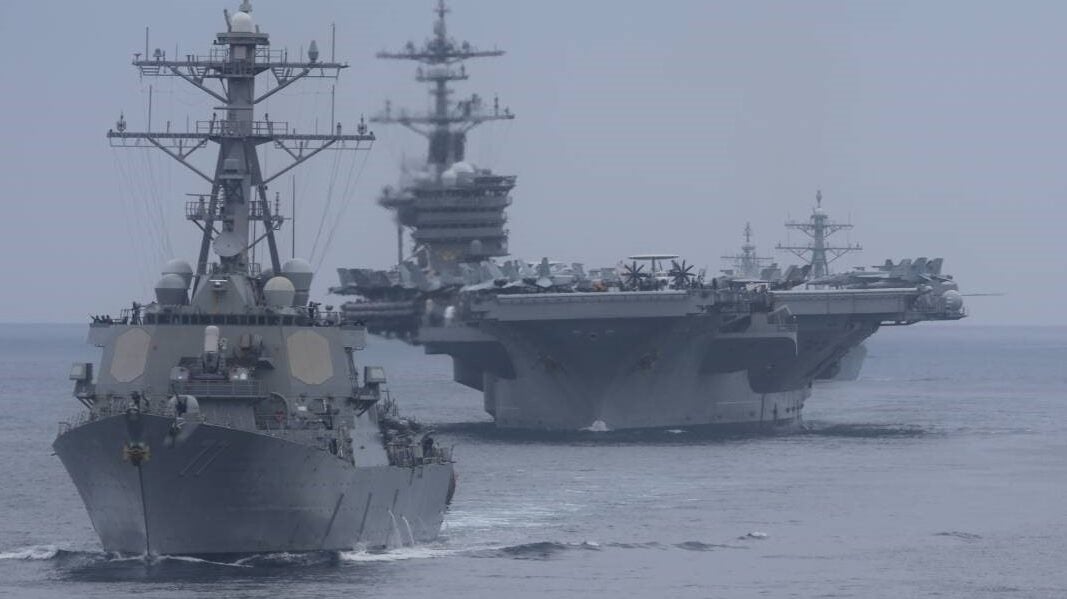
Ships from Carrier Strike Group (CSG) 1, including Nimitz-class aircraft carrier USS Carl Vinson (CVN 70) operating in US 3rd Fleet. (U.S. Navy/Alexander Fraser)
WASHINGTON: The Navy’s choices for this year’s 30-year shipbuilding plan were driven by “uncertainty,” “hard choices” and confronting “fiscal reality,” two senior service officials told reporters today at the official rollout for the long-range planning document.
The service took the unusual step of laying out three different procurement profiles in the plan — the first such document presented to Congress since 2019 — depending on the funding lawmakers provide in the coming years. Two options assume no real growth in the budget and vary slightly in how aggressively the service would be in its efforts to proliferate unmanned systems into the fleet. A third option assumes up to $75 billion in real budget growth down the road.
“The further away in years you get from 2022, the less certain the future is,” said Vice Adm. Scott Conn, the Navy’s top requirements officer. There is “uncertainty in terms of the fiscal budgets that we’re going to have to deal with, and uncertainty with respect to what China and Russia may be doing and being able to produce.”
Jay Stefany, the senior civilian acting as the Navy’s acquisition executive, added that the two lower cost options are meant to act as “floors” for future spending while the third alternative shows where the Navy would direct extra funding if it becomes available.
But which path would the Navy choose if it has its own way?
“Certainly, we would want to have the higher [topline],” Stefany said. “But that we recognize that there is — the overall administration has as a bunch of priorities” and where the Navy’s shipbuilding plan fits in is “something that Congress and the administration would have to figure out.”
Stefany and Conn noted the service was currently conducting a force structure assessment that will impact choices made in the fiscal 2024 budget request, a document on which the Pentagon has already started work.
Shortly after the service published its new shipbuilding plan, lawmakers quickly began chiming in. Perhaps predictably, Republicans jumped on the plan to bash the White House.
“President [Joe] Biden’s shipbuilding plan is a blueprint for American weakness. For years, our Navy fleet has suffered from under investment and a lack of planning to meet our nation’s 355-ship requirement,” said Sen. Roger Wicker, R-Miss., a likely contender to become the top Republican on the Senate Armed Services Committee after Sen. Jim Inhofe, R-Okla., retires this year.
Reps. Rob Wittman, R-Va., and Mike Rogers, R-Ala., both members of the House Armed Services Committee, said the administration ignored its own “military advisors to the detriment of our Navy and Marine Corps’ readiness.”
“The Biden administration’s 30 year shipbuilding plan reduces our ability to protect our aircraft carrier strike groups, reduces Navy’s ability to eliminate an enemy’s minefield, reduces the Marine Corps ability to conduct forcible entry missions and reduces almost 10% of our fleet’s ability to launch missiles,” the two congressman said in a joint statement.
Striking a less pointed tone, Rep. Joe Courtney, D-Conn., who has been highly critical of the Navy in previous years for failing to regularly produce a shipbuilding plan, said the document’s publication this year is “welcome.” (Federal law mandates the Navy deliver a long-range plan to Congress every year, although the Pentagon has failed to do so in the last three years.)
But he then indicated that as nice as the Navy’s plan may be, Congress will move in its own direction, saying “There are several areas in this plan that require a ‘measure twice, cut once’ approach — now that we have the Department’s view, Congress has the opportunity to take its own second measure of the proposal and make its mark before irreversible decisions are made.”
When asked about lawmakers’ early reactions, Conn said the service made “difficult choices” based on “fiscal reality.” He cited the numerous ships the service wants to decommission ahead of their scheduled end of service life as an example.
“When you look at what it would take to buy those ships back, it’s over $7.2 billion” inside the next five years, Conn said. “We believe that there’s better use of those taxpayer resources… So that is how I would respond to Congress.”
Stefany, the acting acquisition executive, said Congress could also expect to receive the service’s long-range ship maintenance plan within the next two weeks. That planning document was first devised by Stefany’s former boss, Hondo Geurts, to forecast to industry what the Navy’s maintenance needs will be in future years. The Navy has not consistently delivered that document to Congress in past years either.
GD chief says Navy’s 1 sub buy won’t impact company short term, but out years less certain
The comments from the General Dynamics chief come on the same day President Joe Biden signed the national security supplemental, which includes billions for the sub industrial base.



























